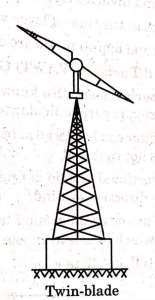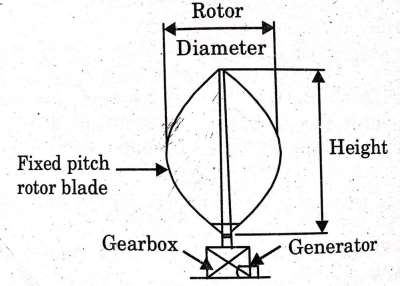Table of Contents
Introduction To Wind Energy
Wind energy is a form of renewable source of energy generated from the kinetic energy of wind.
- It works when air blows; then wind turns the blades of a turbine that spins a generator to produce electricity.
It is a clean and sustainable source of energy that doesn’t deplete natural resources or produce harmful emissions, making it a vital component in the fight against climate change.
- It comes from the sun in an indirect way because of wind blows due to the uneven heating of the earth by the sun in different regions.
- The energy of wind is harnessed by utilizing a windmill.

Image: Wind Energy
- A windmill consists of big sizes, table fan- like blades which are fixed over the top of a tall pole in such a way that they are freely to rotate or move.
- The windmill used for generating electricity is called a wind turbine, and the complete set – up of generating electricity by using wind energy is term as ‘ wind generator ‘.
Definition of Wind Energy
- Wind energy is the process of converting the kinetic energy of wind into electricity by using wind turbines.
- It is a clean, eco- friendly, safe and renewable source of energy.
Facts of Wind Energy

Image: Wind Energy
- It is one of the fastest growing and most widely used sources of renewable energy on the planet.
- It is a clean source of power that causes minimal pollution and mass production, government subsidies and advancements in turbine technology are making it more affordable than ever before.
- The first modern turbine was built in the 1940’s in Vermont which belongs to USA.
- Wind energy has been utilized to fill sails and move ships through the sea for a long time.
- The Babylonians and Chinese, they were used wind energy to pump water for irrigating crops 4,000 years ago.
- In Persia and China, wind energy was first developed with windmills in 200 BC.
- Wind energy is unique for the fact that it doesn’t require water.
- A single commercial turbine can easily power 600 homes or a small business.
Also read on touching the link:-
- Solar Cell in details
- Networking in details
- Geothermal Energy
- Heat Treatment
- Heat Transfer
- Energy
- Heat
- Light
Working of Wind Energy Conversion System ( WECS )
- There are two types of wind energy conversion system which are as follows:
1. Horizontal axis wind turbine ( HAWT ) generator
2. Vertical axis wind turbine ( VAWT ) generator
1. Horizontal axis wind turbine ( HAWT ) generator
 Image: Wind Generator
Image: Wind Generator
- In HAWT generator, there are two types of propeller:-
a. Up wind
b. Down wind
a. Up wind
- In the up wind type, the blades are slanted and wind approaching the blades from front side and nacelle is placed on rear side of the blade.
b. Down wind
- In down wind design, wind approaching blades from nacelle side.
- HAWT are divided according to the blade which are mounted on hub:-
a. Mono blade
b. Twin blade
c. Three blade
d. Multi blade
a. Mono blade
- The mono blade HAWT are simple in construction and lighter in weight, low price, easy to install and have easy maintenance.
- Mono blade turbines are equipped with synchronous generator and experience minimum stress on bearing.

- This HAWT produce low power of 15 kW to 50 kW with length of the blade varying from 15-25 m.
- They are mostly used for pumping, battery charging and power supply to farmhouses.
b. Twin blade
- Twin blade HAWT is less costly than three blade types but have large vibrations while running.

- The teething control is provided with these machines to reduce the fatigue on main shaft.
- This machines are rated from 1 to 3 MW.
c. Three blade
- Three blade HAWT has a 3 phase synchronous generator or a 3 phase induction generator to operator at constant speed and axis of nacelle is oriented so that plane of turbine blades is perpendicular to wind direction.

- To change the generator shaft speed, a gear chain is provided from turbine shaft.
- This HAWT produce smaller to longer units i.e., from 15kW to 3MW units.
d. Multi blade
- The multi- blade turbines are high solidity turbine used for pumping the water because of high starting torque characteristics.

Image: Multi- Blade
- The multi- blade rotors are less efficient due to interference of blades in each other but they are less noisy.
Advantages of Multi- Blade
- Energy cost/kWh is lower.
- Higher power generation
- Disadvantages of Multi- Blade
- Design is complex and involves control problems.
- High stress develops at the time of large wind speed.
- Repair, installation and maintenance are difficult.
2. Vertical axis wind turbine ( VAWT ) generator
- Vertical axis wind turbines are also known as cross – wind axis turbine and the axis of rotation is perpendicular to the direction of the wind.
- In VAWT, the generator can be placed at base level or within the support tower and nacelle is not required.

Image: Vertical Axis
- VAWT are omni directional and do not need the yaw control to orient the rotor axis in the direction of wind.
- These turbines are mounted on ground level and have blades that go from top to bottom which look like an egg beaters.
- VAWT stands 30m tall and 15m wide.
- VAWT are classified into three categories:-
a. Savonius
b. Darrieus
c. H- shape rotor
a. Savonius

Image: Savonius Wind Turbine
- The rotor of these turbines are ‘S’ shaped and supported at the top and bottom by two circular plates.
- Savonius rotor rotates for air flow in any direction and they are self starting, and having low speed and low efficiency.
- This is a drag type VAWT turns relatively slow, but yields a high torque.

Image: Savonius Rotor ‘ S ‘ shape
Advantages of Savonius
- This type of rotor operates at low velocity of wind.
- There is no need of yaw and pitch control.
- Generator can be mounted at the ground level.
- Low cost.
Applications
- Savonius are useful for grinding grains, pumping water etc.
b. Darrieus
- These turbines have vertical blades that rotate into and out of the wind and by using aerodynamic lift, these turbines can capture more energy than drag devices.

Image: Darrieus Type Wind Turbine
- The rotor rotates on two bearing placed on the top and bottom of pipe, with wind blowing from any direction. But the rotor is not self starting and needs auxiliary starter.
- The wind turbine is anchored on ground by wire ropes and generator is mounted on the ground.
Advantages of Darrieus
- The generator, gear box etc. are placed on the ground.
- No need of yaw mechanism to turn the rotor against the wind.
Disadvantage of Darrieus
- These turbines suffer a problem of stalling when wind speed is very high.
c. H- shape rotor
- In this types of turbine, two vertical blades are joined by a horizontal beam to form H- shape and the horizontal beam is mounted on the tower with hub at the centre of the horizontal beam.
- H– rotor and horizontal beam are designed as aerodynamic foils and H- shape rotates around the vertical axis.

Image: H- shape Rotor
- In this type, the generator is placed at the upper and coupled with the rotor through gear system.
- The blades of the rotor are either fixed type or variable shape in terms of angle.
- For smaller ratings fixed type is used and for higher ratings variable shape blades are used.
Factors for the selection of a site for Wind Energy
- Low land cost.
- Approach roads upto site.
- An area should be open and away from cities.
- Height of tower will increase where tress are present.
- Minimum wind speed is available throughout the year.
- Ground surface should be stable and high soil strength.
- The proposed altitude is to be selected by taking average wind speed data.
- The flat open area should be selected, as the wind velocities are high in flat open area.
- To minimize the transmission losses, the wind power should be near the consumers.
- It should be at least 5km away from the cities to reduce the effect of sound pollution.
Uses of Wind Energy
- There are various uses of wind energy:-
1. Electrical
- The generators are usually driven through gear box to generate electricity and turbines use low solidity rotor.
- The energy produced is stored in batteries or can be directly used.
- The aero generators are available upto capacity of 250kW for small unit.
- A larger turbines are grouped together, which provide bulk power to the electrical grid.
2. Mechanical
- Ocean transportation.
- Mechanical heat pump.
- Supplying drinking water.
- To supply compressed air.
- Food processing industries.
- Pumping of water at high reservoir.
- Production of plastics and synthesis.
- Churning of liquids, milk processing, and greenhouse application.
- Production of alcohol, cloning materials and rubber processing plants.
Advantages of Wind Energy
- Low operating cost.
- Economically competitive.
- Wind doesn’t require any transportation.
- It is renewable and available at free of cost.
- It is reliable and cost effective for large units.
- Helpful for supplying energy in rural, offshore, onshore areas.
- It doesn’t involve the consumption of water unlike many other conventional energy sources.
- The electricity generation by wind turbines is pollution free and doesn’t release carbon dioxide.
Disadvantages of Wind Energy
- The efficiency of turbine rotor is less.
- Wind energy generates noise pollution.
- Wind can’t be stored as a conventional source.
- Weight of power system is high and requires large area.
- Direction of wind changes and is never constant and reliable.
- Wind energy can be useful only at remote areas away from cities.
- The capital cost per kWh is more in small unit with respect to larger unit.
- Large transmission losses as the wind farms are located in remote areas.
- Wind energy has low power density and variable with time and locations.

